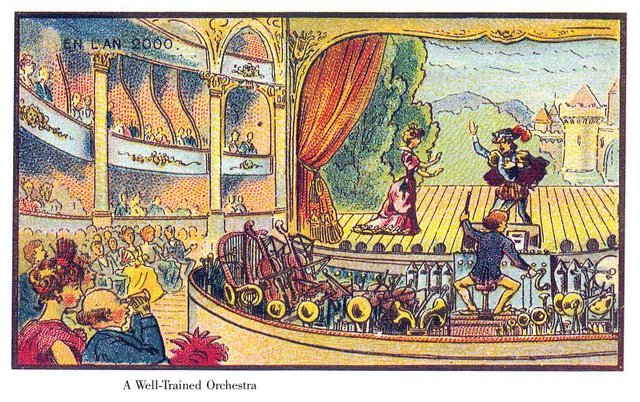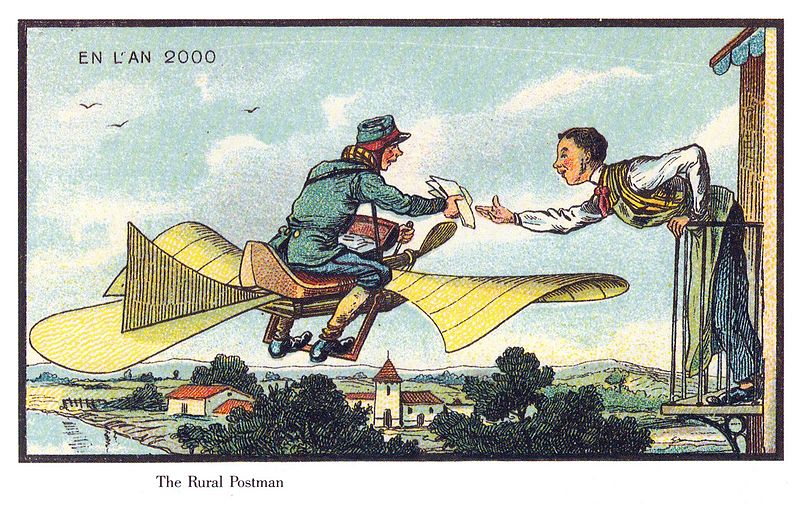Imagining the Future
The Public Domain Review recently published a collection of images called: A 19th-Century Vision of the Year 2000. It is a collection of printed cards by Jean-Marc Côté and other artists which appeared in cigar boxes and as postcards over 100 years ago. As a whole, the collection offers a whimsical look at future technology as imagined by the artists.

As clever as the drawings are, they are strangely limited. Most of the imagined scenes are precisely in line with the technological capabilities of the late nineteenth century. This image shows a conductor operating a mechanized orchestra. Though the drawing is funny and unusual, machines of this type were widely produced at the time for use in carnival carousels with automated music. The drawing is a recombinative imagining of existing technology.

Most of the images deal with mechanism, and there are many drawings of airplanes of one kind or another. At the turn of the century, the invention of the airplane was a worldwide project, a fervor that had captured the global imagination. The airplane drawings in the series show an endless variation on this emergent technology. The artist assumes that the current technological drive will continue to grow over the next hundred years.

There is only one image in the collection that hints at the rise of information technology. It depicts a classroom scene where books are fed into some kind of electrical processor and their information is transmitted to students via metal caps wired to a network. In this example the artist has done more than repositioned familiar technology and created something which truly breaks the framework of the times. It would have been possible for a turn-of-the-century thinker to imagine the computer through combining, say, a typewriter with a telephone, and Charles Babbage and Ada Lovelace had created a machine called the difference engine, a mechanical precursor to the computer in 1822. There were definite reference points for the computer, but the artist has a different goal: to say something about the nature of information with uncanny accuracy. In the future, information will no longer be an individual possession; it will exist in aggregate, in a massive torrent that each individual will be able to access and contribute to, but no one will own.
When imagining the future, it is almost impossible to think outside of the existing framework and imagine something entirely new. Explanation requires metaphor, and metaphors require comparison with something familiar. Technology that is truly new must break the framework, or tunnel through it, perfectly emulating and then replacing existing ideas.
For instance, an LED display is completely different technology than the cathode ray tubes they replaced, but since the end application is the same, the technology is interchangeable in the public mind.
Similarly, the underlying principles of dial-up modems of the late 1980s and early ’90s were utterly unrelated to the high-speed data services we use now. Dial-up modems used sound to encode, transmit, and receive data over normal phone lines. In order for the framework to change, the new technology had to infiltrate and usurp the old. Sending data over auditory transmission is a fascinating idea, but no one will pursue it now that it has been made irrelevant.
In the 1930s, New York City Mayor Fiorello LaGuardia dismantled the city’s electric cable car system to make way for the new technology that was transforming America: the automobile. New York’s cobblestone streets were smoothed over with asphalt to accommodate the changing times. Now, almost a century later, the city is choked with traffic and cobblestones are being put back in to slow down drivers. Thanks to the Tesla company, the paradigm is shifting toward a new technological era of electric transportation, and it’s not impossible that plans for the same public transportation system that existed in New York a century ago might be reasonably considered by city officials. After all, electric cable cars are environmentally friendly and can move people more efficiently than individual taxis stuck in gridlock.
The proposition of the EOS global network is to move the entire framework of technology, and so it must infiltrate the technology it will replace.
EOS Dublin CEO Sharif Bouktila is focused on applications.
“We shouldn’t even call them dApps, “ he said. “We shouldn’t differentiate our applications from others; they should co-exist in the public arena.”
Sharif’s view is that mass adoption will occur organically.
“People won’t even realize they are using a different technology. They can have exactly the same app experience, except they’ll slowly come to realize that it works better, it’s more secure, or they’ll get paid for using it.”
Radical shifts in the framework occur gradually. The new technology must replicate the old before the framework changes. The insider’s perspective celebrates how radical the change will be, but mass adoption will only occur when individuals view the apps as a little bit better than what they already use. The average person won’t know or care that the technology is different, they’ll just know that their app works better.
It’s similar to how most of us went through the transition from dial-up internet to high-speed data without realizing the technology was totally different. The end result was that it was just faster and better. We could not have reached the current stage without the intermediary. The dial-up era was a necessary proof-of-concept, and without it no one would have understood why we needed a high-speed data network.
True innovation changes the framework, and outpaces metaphor. This is why EOS is hard to explain. You might find yourself saying things like: “Imagine AirBnB, but without AirBnB. Imagine Facebook, but with no Facebook. Imagine Google Maps, but with no Google.” There is simply no way to understand it because there is no reference point. When people tried to describe the emergent technology of the automobile they called it a horseless carriage, in other words: “Imagine a horse and cart, with no horse.”
Because of our frame of reference, it is a null prospect to evangelize and explain. It’s impossible. It isn’t like anything. In order for people to truly understand, they’ll have to use the apps and discover the difference for themselves. Only in retrospect, perhaps years from now, they’ll look back and realize that everything changed without their realizing it.
--Isaac Peterson is a novelist and part of the EOS Dublin team.
http://publicdomainreview.org/collections/france-in-the-year-2000-1899-1910/
Very interesting read, thank you kindly.
hi
Posted using Partiko Messaging
Congratulations @isaac1! You received a personal award!
Click here to view your Board
Congratulations @isaac1! You received a personal award!
You can view your badges on your Steem Board and compare to others on the Steem Ranking
Vote for @Steemitboard as a witness to get one more award and increased upvotes!